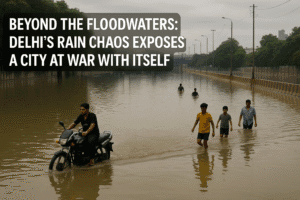Beyond the Floodwaters: Delhi’s Rain Chaos Exposes a City at War with Itself
Heavy monsoon rains battered Delhi on Tuesday, plunging the city into familiar chaos as streets flooded and traffic gridlocked. The glaring failure was epitomized by the submerged Zakhira underpass, where six-foot-deep water halted all movement, exposing the hollowness of civic authorities’ “monsoon-ready” claims. Shockingly, a mere 8mm of rainfall was enough to overwhelm outdated drainage systems across key areas like Windsor Place, Kirari, and Akshardham.
While the downpour offered a temporary reprieve by cleansing the air and dropping temperatures, it laid bare decades of infrastructural neglect and poor urban planning. Systemic issues like encroached waterways, fragmented agency responsibility, and rampant concretization leave the city perpetually vulnerable.
With the IMD issuing Red and Yellow alerts forecasting more heavy rain and thunderstorms until August 3rd, the immediate crisis is far from over. This recurring flooding underscores Delhi’s urgent need for resilient, climate-adapted infrastructure beyond temporary fixes. The rains may wash away pollution, but they also force a stark reckoning with the city’s unsustainable relationship with water and governance.

Beyond the Floodwaters: Delhi’s Rain Chaos Exposes a City at War with Itself
The rhythmic drumming of monsoon rain on rooftops brought a collective sigh of relief to Delhi on Tuesday, momentarily breaking the oppressive grip of summer. But within hours, that relief curdled into familiar frustration as the capital transformed. Streets became rivers, underpasses turned into lakes, and the city’s perennial struggle with waterlogging erupted once again, laying bare deep-seated infrastructural wounds.
The Unfolding Crisis: The image of North Delhi’s Zakhira underpass, submerged under nearly six feet of murky water, became the stark symbol of the day. Vehicular movement between Zakhira and Moti Nagar ceased entirely. Visuals captured the surreal scene: intrepid two-wheeler riders navigating treacherous depths, pedestrians and even children wading waist-deep – some cautious, others finding grim amusement in the city’s dysfunction. This wasn’t an isolated incident. Windsor Place resembled a canal, Kirari Assembly constituency battled extensive flooding forcing vehicles to crawl, and Akshardham witnessed nightmarish traffic snarls as stormwater stubbornly refused to drain.
Hollow Promises, Stark Reality: The deluge served as a brutal audit of civic preparedness. Despite repeated assurances that drains were cleaned and systems were “monsoon-ready,” just 8 mm of rainfall (as recorded by the IMD ending 8:30 AM Tuesday) was enough to paralyze key arteries. The scene at Zakhira itself told a story of systemic failure: only two of the three deployed PWD pumps were operational, with workers scrambling to fix the third – a microcosm of the delayed and insufficient response residents have come to expect. The much-touted pre-monsoon clean-up drives now rang hollow as citizens navigated submerged streets, questioning the efficacy of governance when promises dissolve with the first heavy downpour.
Beyond the Chaos: Silver Linings and Systemic Flaws: Amidst the disruption, the rain offered tangible benefits. It washed away dust and pollutants, plunging the Air Quality Index (AQI) into the ‘satisfactory’ range in Noida, Greater Noida, and Ghaziabad – a rare reprieve for one of the world’s most polluted regions. Health experts noted the cooler temperatures (a minimum of 26.8°C, 0.5° below average) and cleaner air would bring vital relief, especially for vulnerable populations like the elderly and those with respiratory conditions. This duality – destruction alongside cleansing – underscores the complex relationship Delhi has with its monsoon: a life-giving force that simultaneously exposes life-threatening vulnerabilities.
The Root of the Flooding: Experts point beyond the immediate drainage clogging to deeper issues:
- Outdated Infrastructure: Much of Delhi’s drainage system was designed decades ago for a smaller population and less intense rainfall patterns, now overwhelmed by urbanization and climate change.
- Encroachment & Silting: Illegal construction choking natural water channels and decades of silt accumulation drastically reduce drainage capacity.
- Lack of Integrated Planning: Fragmented responsibility between multiple civic agencies (MCD, PWD, DJB) often leads to coordination failures and buck-passing.
- Concretization: Widespread paving prevents rainwater percolation, increasing surface runoff that overloads drains.
The Road Ahead: More Rain, More Questions: The IMD’s forecast offers little comfort. With a Red Alert for southeast and northeast NCR and a Yellow Alert elsewhere, more heavy rain and thunderstorms are expected until at least August 3rd. The threat extends nationally, with predictions of “heavy to extremely heavy rainfall” across parts of India until August 4th. Northwest India, including neighboring states like Punjab, Haryana, and Rajasthan, also braces for intense downpours.
A City at an Inflection Point: Tuesday‘s inundation wasn’t just about a few hours of rain; it was a symptom of a metropolis grappling with its own growth and the climate crisis. The recurring waterlogging is a harsh reminder that Delhi’s battle isn’t merely against the monsoon, but against decades of inadequate planning, infrastructural neglect, and a failure to adapt to changing environmental realities. While the rain cleansed the air, it also flushed into view the urgent need for resilient, sustainable urban infrastructure – a need that demands solutions far more substantial than temporary pumps and hollow promises. The true test lies not just in surviving the next downpour, but in fundamentally rethinking how Delhi lives with water.
You must be logged in to post a comment.